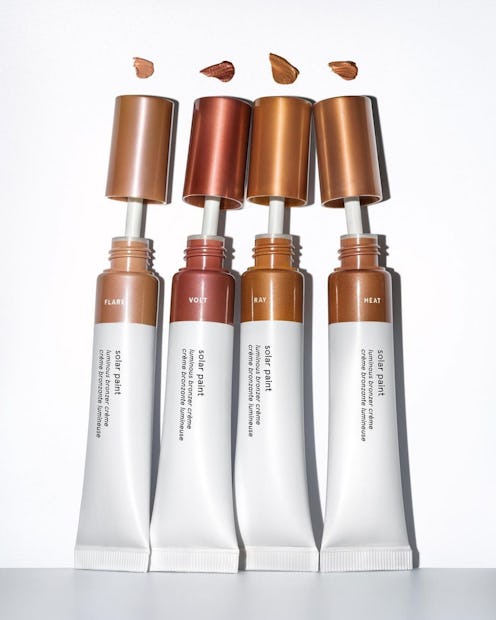(Makeup)
Solar Paint Is The Sunkissed Glossier Bronzer You’ve Been Waiting For
“Instant summer skin.”

If you’re a Glossier fan, you’ve been waiting for it. The cult-favorite brand has become synonymous with fresh, dewy skin since 2014, thanks to its glow-giving skin care, makeup, and body care. However, until today, it's neglected a crucial summer beauty staple that customers have been begging for: bronzer. Enter the newest member of the Glossier family: Solar Paint.
If the name sounds familiar, that’s because the brand new bronzer is the sunkissed sister of Glossier’s oh-so-blendable gel-cream blush, Cloud Paint. “Designed to capture the warm glow you get from spending a day in the sunshine, Solar Paint’s gel-crème formula brings a thoughtful balance of warmth and dimension to the face (so it looks just as natural in broad daylight as it does in the mirror),” the brand says in an official press release.
The lightweight bronzer is available in four “community-tested” shades:
- Flare (for fair-light skin tones)
- Ray (for light-medium skin tones)
- Heat (for tan-deep skin tones)
- Volt (for deep-rich skin tones.)
Solar Paint comes with a doe foot applicator for precise application, and the light, almost-whipped formula makes it fingertip-friendly. For an all-over glow, the brand recommends applying it to the top of your forehead, chin, apples of the cheeks and bridge of your nose. For a sculpted effect, they suggest applying to the hollows of your cheekbones, around the face, and along the jawline.
Like most Glossier products, Solar Paint is also infused with skin-boosting ingredients. Nourishing extracts like jojoba and aloe combine to create a micro-emulsion Glossier calls “Desert Milk” and botanical Ayursense boosts skin’s luminosity.
Luckily, the TZR beauty team was able to get their hands on Solar Paint ahead of the launch and put it to the test. I personally tried out the lightest shade, Flare. Though Glossier says Solar Paint can be used to contour the face, I didn’t love how it looked in the hollows of my cheekbones, as it has a warm undertone and subtle shimmer. However, it works beautifully as a bronzer-blush hybrid on my cheeks and across the bridge of my nose. It gives a natural glow and dries down so it stays in place. I tried blending with a brush, sponge, and my fingertips, and found that a sponge or my fingers worked best.
Here’s what others are saying:
Hannah Baxter, Deputy Beauty Editor
“I used the lightest shade offering, Flare, which was a little darker than I was expecting. I was surprised by how well this bronzer stayed put throughout the day, especially considering it's a creamy finish. The applicator made it super easy for contour application, but it did have a slight shimmer that I don't really vibe with (I prefer a more natural-looking effect with my bronzer). If you were using it to mimic a sun-kissed look, this formula would probably be right up your alley, but I wouldn't necessarily grab it to sculpt my cheekbones.”
Natasha Marsh, Beauty Features Writer
“I requested the shade Ray which is just a tad too dark for my complexion. I’m probably somewhere in between Flare and Ray, but closer to Ray. It’s quite lightweight and has a great glowy finish. I also like how bendable it was with a few swipes of blush.”
Kelsey Stewart, Fashion & Beauty Writer
“If I'm doing my makeup, I rarely finish the look without contouring my face with some sort of bronzer. So needless to say, I was ecstatic to get my hands on this new product from Glossier. I decided on Flare, which I believe is the perfect shade for my fair skin. While the finish isn't as visible as I would like it to be, you can easily apply a few layers without it looking too intense. I suggest swiping on a powder bronzer over it for extra oomph.”
We only include products that have been independently selected by TZR's editorial team. However, we may receive a portion of sales if you purchase a product through a link in this article.
This article was originally published on